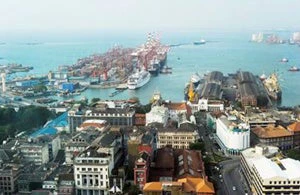
To understand how connectivity can strengthen and capitalize on a system of cities, the World Bank’s South Asia urban team in collaboration with the World Bank Institute, organized a webinar on “Connecting Cities for Growth” on March 11, 2013. The session explored some pressing questions: how does connectivity affect urban development and inclusive growth? How do cities and regions collaborate to achieve mutual advantage of pooling connectivity resources? What are the roles of stakeholders?
Mr Anand Bhal, Economic Advisor in the Ministry of Urban Development, shared that India, like many other South Asian countries, is preparing strategic plans for new corridors, like the Golden Quadrilateral, to connect primate cities with secondary cities or emerging urban areas. India seeks to exploit the potential gains from rapid urbanization through investments in transportation infrastructure and increase connectivity between regions to sustain its GDP growth rate.
Why are physical and economic connections important for growth?
A well-connected system of cities presents immense opportunities to transform large metropolitan areas, undergoing a post-industrial transition from a heavy manufacturing to higher value-added industry and service-oriented economy. Industries tend to relocate to secondary cities, which are well connected, to reduce high costs associated with labor, raw materials, and land in mature cities. For example, urban growth in Korea moved south, in five main cities along the regional corridor and away from Seoul.
Professor David Dowall, shed light on the ripple effect of poor regional connections, which result in lower labor productivity, supply-chain inefficiencies, high prices, and disconnected labor-product markets. Well-connected inter-city and intra-city regions mitigate these impacts, and result in larger labor markets, increase employment opportunities, and reduce congestion costs.
Korea constructed an expressway network, total length of 2,600km, between 1970 through 2000. Dr Jinkyu Chung, Research Fellow at KRIHS, discussed the remarkable reduction in travel time between Seoul and Busan from more than 15 hours to less than four hours due to the expressway connections. This attributed to higher gross regional domestic product, population redistribution, and greater freight traffic volumes.
What are some tools and strategies to consider on intra-city connectivity projects?
Actively manage public perception on the impacts of regional connections. In Korea, people largely associated highways with private vehicles and means to benefit the wealthy, and therefore, protested against the expressway proposal. Despite initial apprehension, once operational, Delhi Metro showcased benefits of public transportation through travel-time saving, cost savings, gender-sensitive strategies, and has successfully changed public perception.
Link poor to prosperity. Professor Dowall, through the case study of Colombo, Sri Lanka, showed strategic advantage of connecting regions with high poverty mass around Colombo and extending eastwards, with the Colombo metropolitan area. The economic activity in Sri Lanka is concentrated in Colombo and a few other cities. This provides an opportunity to connect lagging regions with sources of employment, to increase economic activity, ultimately leading to growth.
Analyze underlying socio-economic factors. In India, strategies for the densely populated, mineral resource rich and agriculture-based regions along the eastern dedicated freight corridor, currently under construction, would be different from those along an industrializing and manufacturing-based economy along its western freight corridor.
Connect nodes that contribute to regional growth. The expressway system in Korea connected urban areas to capitalize on tourism, leisure and sight-seeing as well as economic development led through expanding industrial base along the corridors. Existing land use patterns are important indicators of growth magnets, and connectivity blueprints must be synchronized with upcoming and proposed urban centers. Another important consideration could be facilitating transport of goods from ports to strategic hubs, for distribution to the rest of the country. An example of such intermodal connectivity is the Alameda Corridor linking the twin ports of Los Angeles and Long Beach with national rail system of the US.
If you missed the webinar session, you can view the recording by clicking here. The webinar series is part of our initiative to form a Network of Practitioners, to collaborate, share, and generate best practice policies and strategies to address challenges of an unprecedented urbanization in South Asia. You can become part of this network too! Contact us at southasiaurban@worldbank.org.


Join the Conversation